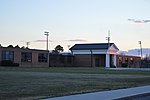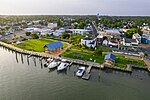Chincoteague National Wildlife Refuge

The Chincoteague National Wildlife Refuge is a 14,000-acre (57 km2) wildlife preserve operated by the U.S. Fish & Wildlife Service. It is primarily located on the Virginia half of Assateague Island with portions (only about 3%) located on the Maryland side of the island, as well as Morris Island and Wildcat Marsh. Mostly composed of beach, dunes, marsh, and maritime forest, the refuge contains a large variety of wildlife animals and birds, including the Chincoteague Pony. The purpose of the refuge is to maintain, regulate and preserve animal and plant species as well as their habitats for present and future generations. Chincoteague National Wildlife Refuge is one of the most-visited wildlife refuges in the country, drawing 1.5 million annual visitors via neighboring Chincoteague, with most arriving in the summer for the public beach. The refuge is also popular for the Chincoteague Island Pony Swim, in which the refuge's herd of ponies is rounded up and corralled before swimming the channel to Chincoteague.
Excerpt from the Wikipedia article Chincoteague National Wildlife Refuge (License: CC BY-SA 3.0, Authors, Images).Chincoteague National Wildlife Refuge
Geographical coordinates (GPS) Address Nearby Places Show on map
Geographical coordinates (GPS)
| Latitude | Longitude |
|---|---|
| N 37.954166666667 ° | E -75.316666666667 ° |
Address
Accomack County
Virginia, United States
Open on Google Maps









